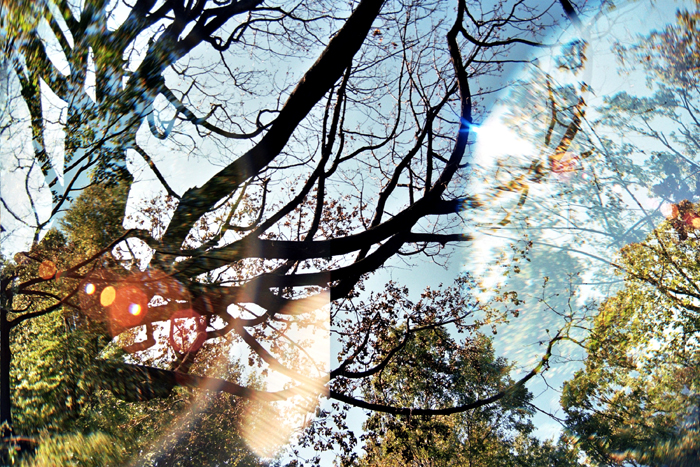Dan Duda and Leah Oates collaborated on the creation of this essay. Leah Oates is a photographer working out of New York City and Dan Duda is a scientific writer living in Lititz, Pennsylvania (USA). This is Dan’s second essay for VJIC on photography and Quantum theory. Leah Oates visual dialog is linked from this essay.
visit: Leah Oates Visual Dialog: Transitory Space
Leah Oates
“Humans leave traces and artifacts of our consciousness everywhere in our environment. Contradictory realities can be found co-existing wherever we look. They’re in what we choose to think; what we choose to believe; and, how we choose to act. And, they can be found in what we choose to observe.”
Dan.
Why has science become so bizarre? Why does it take a super genius to decipher what reality is all about? Why can’t a scientist say ‘this is how it is,’ in a way that everyone
just understands? Well, at least there is a relatively easy answer to those questions. Simply stated, human senses and intellect have developed in a way that is most useful for survival. For example, stereoscopic vision with color perception was valuable for life in forests, trees and plains—comprehending the structure of four levels of the multiverse—not so much. The ability to develop strategies for hunting, gathering and cultivating a continuing food supply is essential. Grasping the significance of wave/particle duality wouldn’t even make it to the current ‘must have for survival’ list. However, a working understanding of these deep issues is critical to our continued technological progress—and understanding existential threats on a macro level just might be needed for the future survival of mankind.
Ironically, art can provide a bridge of understanding to a reality that escapes the severe boundaries of our intuition. Leah Oates is among a group of artists who employs photo techniques that express feelings transcending the limits of our rational perceptive ability.
Leah. When I look back on a moment it’s full of impressions and multiple exposures capture this. I make these exposures on specific frames using a 35mm and medium format camera. This allows me to display a more complete correlation of experiences that a single exposure just misses.
Quantum Tunneling
“According to Quantum Mechanics, a particle has a definite probability of being anywhere in the universe…We can thank [this] Quantum Tunneling for the Sun’s heat.” Tyler Simko
Dan. There are many recent discoveries in particle physics that bend our rational minds to the breaking point (and sometimes beyond). For example, why does the Sun shine? If you ask a scientist he’ll tell you that the enormous mass of our star causes intense gravity which, in turn, causes atoms of hydrogen to fuse into helium. That, in turn, causes the release of photons. Multiplied by all the atoms in the Sun’s core this generates the radiation produced by the Sun and all the other stars in the universe. But in reality, he would be wrong (or at least not totally right). If you do the math you’ll find that there just isn’t enough force in the core of a star to cause nuclear fusion.
However, if you ask a particle physicist that same question, she will tell you that something called quantum tunneling is required for fusion. The Pauli Exclusion Principle tells us, in part, that no two particles can occupy the same space—the electron cloud will resist any such possibility. But this can be overcome by the more powerful (but extremely rare) action of quantum tunneling. It’s extremely rare, but considering all the material and dynamics at the core of the Sun it happens often enough to cause the Sun to shine providing all the energy we encounter on Earth.
At the root of quantum tunneling is the fact that an individual particle can (and does) exist in more than one place at a time. You’re tempted to say ‘oh well, things are really strange in the sub-microscopic’ world but that doesn’t affect me at all. But in our reality we have to keep in mind that everything is made from these particles—including us.
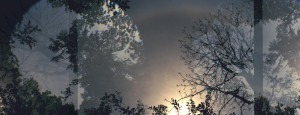 Leah. Every moment captured on film is over as soon as the shutter clicks, recording the ephemeral. Yet, in reality, there is always a visual cacophony of experience. The concept of quantum tunneling doesn’t surprise me. We are always living in many realities at once. Multiple exposures express the way we experience the world more accurately.
Leah. Every moment captured on film is over as soon as the shutter clicks, recording the ephemeral. Yet, in reality, there is always a visual cacophony of experience. The concept of quantum tunneling doesn’t surprise me. We are always living in many realities at once. Multiple exposures express the way we experience the world more accurately.
Wave or Particle
“I insist on the view that ‘all is waves.’” Erwin Schrödinger
Dan. One of the most outrageous concepts to be proposed in science (or in any other field for that matter) is Erwin Schrödinger’s explanation of the reality of a particle as it moves through space. It really started with Niels Bohr, Werner Heisenberg and a host of other scientists at the beginning of the 1900’s. Their experiments consistently showed that a particle behaved differently when it was observed by a human than when it wasn’t (see the Two Slit Experiment). Albert Einstein (and others) hated this result and the statement it seemed to be making about reality (“God does not play dice with the universe.”). But in spite of an onslaught of attacks, experiment after experiment continues to confirm a weird fact—as matter moves through space (unobserved) it exists as a wave occupying every possible position, and possessing every possible attribute. However, when observed, this “wave” collapses in a single place and with a single set of attributes.
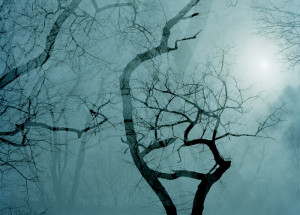 Leah. As un-intuitive as wave/particle duality is, it provides, perhaps, the best metaphor for explaining my approach to photography. The wave of possibilities is analogous to what there is to experience. The “observation” is like the click of a shutter that forces the scene to take just one, limited, ephemeral form. Multiple exposure allows me to present a broader range of experience which is actually more accurate of the reality.
Leah. As un-intuitive as wave/particle duality is, it provides, perhaps, the best metaphor for explaining my approach to photography. The wave of possibilities is analogous to what there is to experience. The “observation” is like the click of a shutter that forces the scene to take just one, limited, ephemeral form. Multiple exposure allows me to present a broader range of experience which is actually more accurate of the reality.
Time
“My ideas about time all developed from the realization that if nothing were to change we could not say that time passes.” Julian Barbour
Dan. Some scientists feel that what we perceive as time is just change masquerading as our fourth dimension. There’s probably no concept in physics more counter-intuitive than the idea that time doesn’t exist. After all, you started reading this article at one
point, but now you’re reading these words. Doesn’t the distance between those two events require a passage of time? Well, within the limited scope of our intuition, time must exist. But we continue to find, time after time, that our innate intuition is far too limited to comprehend reality. And it looks like our perception of time will be another casualty of that limitation.
So, you ask, if time doesn’t exist, at least not as we perceive it, how can we explain the phenomena we experience? Let’s start with our good friend Albert Einstein who said “people like us who believe in physics know that the distinction between the past, the present and the future is only a stubbornly persistent illusion.” For him, the classical understanding of time began to fall apart with his insight on relativity. In that breakthrough theory, time is just another dimension like up/down; backward/forward; and, left/right. And it’s not constant—the speed of time’s passage that affects us depends on the impact of motion and gravity.
Then what is it that occurs making us think that time is passing? According to particle physicist, Julian Barbour, it’s change. “It is utterly beyond our power to measure the changes of things by time. Quite the contrary, time is an abstraction, at which we arrive by means of the changes of things.” Some of the most successful equations in physics are completely devoid of a time component.
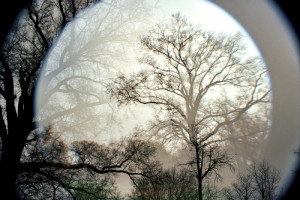 Leah. Time is layered and not frozen into one single moment. Photography is directly connected to time as the camera shoots in fractions of a second. Time is always slipping and fracturing from the present, past and future. We are often living in all these levels at once. But when we’re not, we experience flow—or an absence of time. Multiple exposures are close to the experience of “flow.” When I look at a moment in time I “feel” more than can be recorded with a simple click of the shutter. Standard techniques and even digital capabilities consistently disappoint me. The image never fully reflects what I “saw” or felt. I use multiple exposures on film to record a more accurate picture of how we can recall time transpiring.
Leah. Time is layered and not frozen into one single moment. Photography is directly connected to time as the camera shoots in fractions of a second. Time is always slipping and fracturing from the present, past and future. We are often living in all these levels at once. But when we’re not, we experience flow—or an absence of time. Multiple exposures are close to the experience of “flow.” When I look at a moment in time I “feel” more than can be recorded with a simple click of the shutter. Standard techniques and even digital capabilities consistently disappoint me. The image never fully reflects what I “saw” or felt. I use multiple exposures on film to record a more accurate picture of how we can recall time transpiring.
Consciousness
Johnjoe McFadden believes that consciousness is an electromagnetic field which escapes (or enters) the body through the synaptic gaps between neurons: “The theory solves many previously intractable problems of consciousness and could have profound implications for our concepts of mind, free will, spirituality, the design of artificial intelligence, and even life and death,” he said.
Johnjoe McFadden, School if Biomedical and Life Sciences, University of Surrey (UK)
Dan. A neurosurgeon once compared the human brain to the bridge on the Starship Enterprise. He could map a brain, identifying all the control systems. He was amazed at how effective this mapping process could be—it explained almost everything. But he was troubled by one fact—he could never find Captain Kirk. He couldn’t locate the force that activated the controls. The thing that pushes the buttons. The real seat of consciousness.
Professor McFadden’s idea that consciousness is really an electromagnetic field is striking. If true, that would shed new light on a lot of mysteries. In fact, we know that light itself is an electromagnetic (EM) phenomenon. Think about a current theme in sci-fi relating to near death experience: “go to the light,” [Ghost Whisperer] or “stay away from the light.” [Poltergeist] Or religious references “I am the light…” Carl Jung would also be pleased. An EM field would go a long way in explaining his collective unconscious. “My thesis then, is as follows: in addition to our immediate consciousness, there exists a second psychic system of a collective, universal, and impersonal nature…” [Archetypes and the Collective Unconscious, Carl Jung]. That could be our personal EM interacting with a broader ‘collective,’ or even a universal EM field.
The idea that consciousness might be an electromagnetic field certainly addresses a lot of issues. It might also help explain savants, psychic phenomenon like telepathy, meditation, ghosts, auras, and psychokinesis—to the extent any of those are real. Am I my body—or is my body just something I inhabit? If I’m more than my body—then what, and where am I? In a sense an artist like Leah Oates deals with questions like this. The apparent abstraction of images created with multiple exposure could be a subconscious attempt to portray something our “rational,” intuitive mind just can’t grasp—much less put into words.
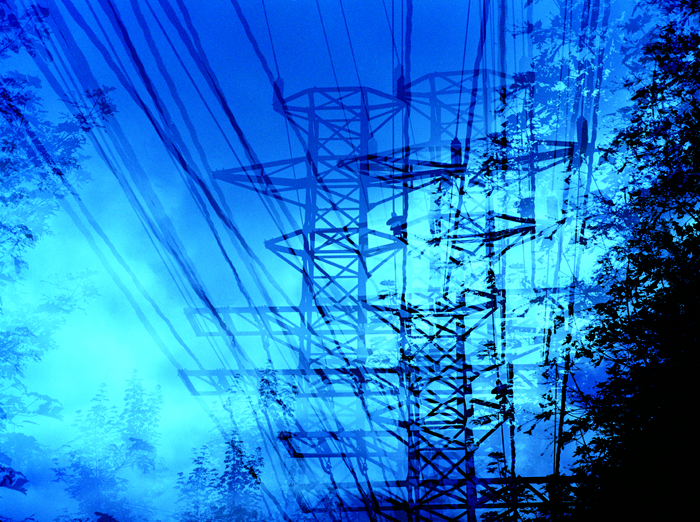 Leah. Let’s face facts—above all else photography is a process dealing with light.
Leah. Let’s face facts—above all else photography is a process dealing with light.
So, if consciousness is somehow tied-into this electromagnetic force, then photography is clearly recording consciousness at one level—or many. The idea of consciousness spilling out of an individual’s brain and mixing into a wider context or environment is a compelling idea. Can my multiple exposure technique help to unveil a better understanding of consciousness? I’m not sure. But I do know that at the heart of this art are feelings that cannot be expressed in words—or even concepts we currently embrace.
Conclusion
Dan. There’s a well-worn cliché dealing with progress—“thinking outside the box.” It may be overused as a metaphor, but the action precedes every major breakthrough in science and technology. Copernicus; Galileo; Newton; Einstein; Bohr and others broke the barriers of the state-of-the-art thinking of their times. And the metaphor applies to art as well—Da Vinci; Michelangelo; Monet; Picasso; Adams; Avedon and others broke visual barriers and rewrote the definition of art and the way it communicates. I find it ironic that, so often science and art cross paths intersecting at ‘philosophy.’ They both dig deep into the essence of reality searching for meaning that escapes prevailing intuition. I challenge the reader to look more deeply and ponderously into the art of Leah Oates. The message that emerges may just be more than aesthetic (and it certainly is that)—it may be a fresh glimpse into the true nature of reality.
visit: Leah Oates Visual Dialog: Transitory Space

